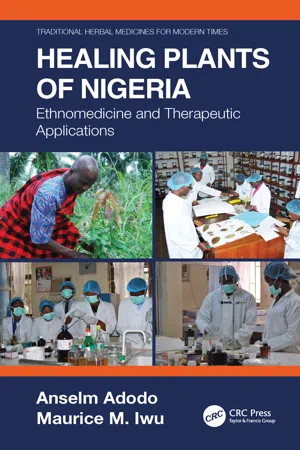
Healing Plants of Nigeria
Ethnomedicine and Therapeutic Applications
- 310 pages
- English
- ePUB (mobile friendly)
- Available on iOS & Android
About this book
Healing Plants of Nigeria: Ethnomedicine and Therapeutic Applications offers comprehensive information on the use of herbal medicines in West Africa. Combining an evidence-based, ethnobotanical perspective with a pharmacological and pharmaceutical approach to phytomedicine, the book bridges the gap between the study of herbal plants' pharmacological properties and active compounds for the development of clinical drugs and community-oriented approaches, emphasising local use. It demonstrates how the framework of African traditional medicine can be preserved in a contemporary clinical context.
The book outlines the history and beliefs surrounding the traditional use of herbs by the local population alongside their application in contemporary phytotherapy in Nigeria and West Africa. It features a critical assessment of the scientific rationale behind the use of these plants in ethnomedicine and offers a composite catalogue of phytotherapeutic and wellness agents, detailing the safety profile, efficacy, and scientific integrity of plants used to treat diseases and optimise health.
Features:
-
- An ethnobotanical survey containing over 200 full-colour photographs of Nigerian and West African plants.
-
- A unique combination of ethnobotany and pharmacognosy, bridging the divide between pharmaceutical and community-oriented approaches to herbal medicine research.
-
- Contextual discussion of the therapeutic potential of Nigerian herbal medicine.
-
- Offers a template which can be used to separate the superstitious aspects of ethnomedicine from culturally inherited deposits of knowledge.
A handbook for herbal and natural medicine practitioners, the book is aimed at African thinkers, scientists, healthcare providers and students of pharmacology and ethnomedicine.
Frequently asked questions
- Essential is ideal for learners and professionals who enjoy exploring a wide range of subjects. Access the Essential Library with 800,000+ trusted titles and best-sellers across business, personal growth, and the humanities. Includes unlimited reading time and Standard Read Aloud voice.
- Complete: Perfect for advanced learners and researchers needing full, unrestricted access. Unlock 1.4M+ books across hundreds of subjects, including academic and specialized titles. The Complete Plan also includes advanced features like Premium Read Aloud and Research Assistant.
Please note we cannot support devices running on iOS 13 and Android 7 or earlier. Learn more about using the app.
Information
Part One
1 The Practice
of Medicine
in Africa
1.1 Introduction
1.2 History and Practice of Traditional African Medicine
Table of contents
- Cover
- Half-Title
- Series
- Title
- Copyright
- Contents
- Authors
- Introduction
- Part One
- Part Two Application of Medicinal Plants for Specific Diseases
- Index
- Taxonomic Index